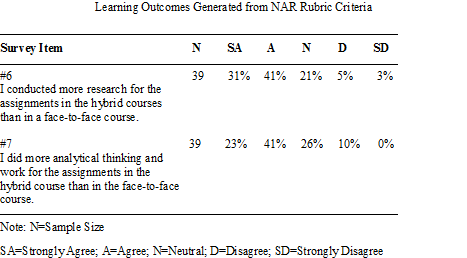| << Chapter < Page | Chapter >> Page > |
Only 6% of the respondents felt the rubric did not provide direction and guidance. In survey item #9 found in Table 1, the students indicated that the assessment feedback based upon the NAR Rubric was very beneficial with 82% agreeing with statement. When the respondents were asked to rate what were the most meaningful and helpful learning activities in the online course, the NAR Rubric was the second most desired learning activity with 19 students. Only case studies ranked higher.
Another set of survey items in Table 2 showed some learning outcomes were generated in online courses because of the key criteria found in the NAR Rubric.
Table 2

The EDAD student’s perceptions of the learning outcomes generated from online assignments were clear and evident. The students believed that they conducted more research for the assignments in the online courses than in the face-to-face courses (survey item #6), and they did more analytical thinking and work for the assignments in the online courses than face-to-face courses (survey item #7). Seventy-two percent agreed with more research being conducted and 64% of the students agreed that additional analytical thinking was produced in online courses. Again, online instruction has the potential to provide opportunities to promote reflective thought and critical thinking through realistically integrating and applying principles learned. Online instruction, such as a simulation, thrusts learners into a learning experience, increasing involvement and providing activities that actively engage learners to analyze, synthesize, and evaluate information while constructing knowledge (Driscoll&Carliner, 2005). Two of the three key criteria found in the NAR Rubric are research and analytical thinking. Thus, a large number of survey respondents perceived that research and analytical thinking are completed in the online assignments by the utilization of the NAR Rubric.
In the 2 open-ended questions, respondents expressed what they liked least about the online course (Survey item #14) and what changes they would make in these courses (survey item #15). When responding to what they liked least or what changes they would make in the hybrid courses, no student expressed dissatisfaction with the NAR Rubric.
In summary, a large percentage of students perceived the NAR Rubric to be beneficial and meaningful when completing the online assignments. Also, they felt that the key criteria found in the NAR Rubric helped produce more research efforts and analytical thinking with the online assignments.
Helping faculty members design assessment tools and practices for online student assignments are paramount. Bauer (2002) identified the emergent problem with online learning as being that of assessing students with traditional assessment measures.
The results of this study demonstrate that students perceive the Narrative/Analysis/Research Rubric as a good assessment tool to guide students in completing online assignments. It is important to note that students thought the NAR Rubric significantly provided direction and feedback in completing online assignments. In fact, students indicate in the study’s survey that it is one of the most helpful items used in the online courses they had taken.

Notification Switch
Would you like to follow the 'Ncpea handbook of online instruction and programs in education leadership' conversation and receive update notifications?